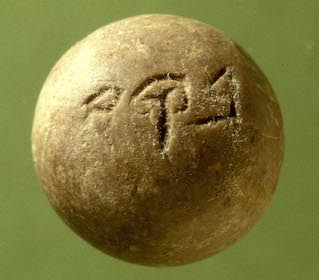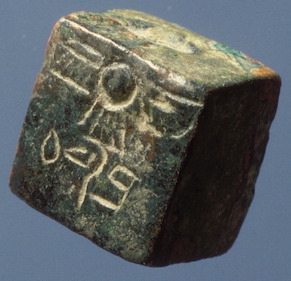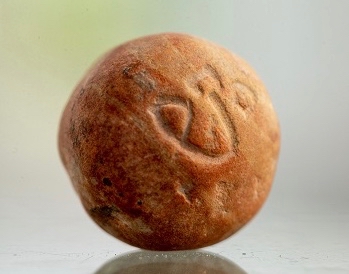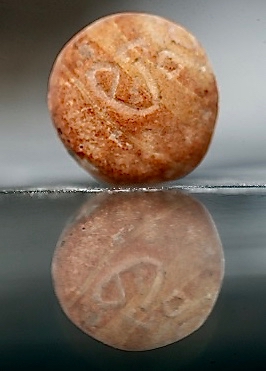
בֶּקַע bèqaʿ – half a shekel (beka)
Semantic Fields:
Weight
Author(s):
Raymond de Hoop, Bertus van ’t Veld *
First published: 2021-02-16
Last update: 2023-05-16
Citation: Raymond de Hoop, Bertus van ’t Veld, בֶּקַע bèqaʿ – half a shekel (beka),
Semantics of Ancient Hebrew Database (sahd-online.com), 2021 (update: 2023)
Introduction
Grammatical type: noun masc.
Occurrences: 2x HB (2/0/0); 0x Sir.; 0x Qum.; 35x Inscr. (Total: 37).
- Torah: Gen 24:22; Exod 38:26.
- Inscr.: Ashdod; Beth-Zur; Ekron; Gezer; Jerusalem (2x); Kh. el-Kom; Kh. Uza; Lachish (3x); Nahal Elteke; Ramat Rahel; Ras Salāh; Shueifat; unknown provenance (22x).1
- Text doubtful: —
A.1 Many weights inscribed with the word בקע have been found;2 while one weight was found with only the ב and one with probably the letters קע (letters not clear on the photograph).3 See section 6.3. Archaeology.
1. Root and Comparative Material
A.1 The word בֶּקַע is derived from בקע, ‘to cleave’, ‘to split’,4 which has, apart from בֶּקַע, a few derivatives: *בְּקִיעַ, ‘breach’, ‘rubble’, and בִּקְעָה , ‘valley’. The latter word is used in a number of locative or topographical names: בִּקְעַת אָוֶן (Amos 1:5); בִּקְעַת יְרֵחוֹ (Deut 34:3), etc.
A.2 The noun בֶּקַע is not attested in the cognate languages.5 However, the root בקע is attested in, for example, Ug. bq‛, ‘to split, open’,6 Moab. bq‛, ‘to break through (of dawn)’,7 LMHebr. בקע, ‘to split, chop’.8
A.3 The BHebr. word בֶּקַע, ‘weight, coin’, is used in quotations from Exod 38:26 in the midrashim, such as Bereshit Rabba (84:18):9 אַתֶּם מְכַרְתֶּם בְּנָהּ שֶׁל רָחֵל בְּעֶשְׂרִים כָּסֶף, לְפִיכָךְ יִהְיֶה כָּל אֶחָד וְאֶחָד מַגִּיעוֹ בֶּקַע לַגֻּלְגֹּלֶת, הֲדָא הוּא דִכְתִיב (שמות לח, כו): בֶּקַע לַגֻּלְגֹּלֶת מַחֲצִית הַשֶּׁקֶל, ‘You sold Rachel’s son for twenty pieces of silver, therefore shall each of you bring a beka a head; thus it is written (Exod 38:26): A beka a head, half a shekel.’10
2. Formal Characteristics
A.1 בֶּקַע is a qatl formation – the most common noun pattern (almost a quarter of all nouns)11 – of √בקע, a root tertiae gutturalis.12
3. Syntagmatics
A.1 In the Hebrew Bible בֶּקַע occurs twice in the singular absolute. No other forms are attested. In epigraphical sources the word is solely used as the designation of the weight on which it is inscribed.
A.2
בֶּקַע
occurs in a nominal clause:
בֶּקַע מִשְׁקָלוֹ,
‘a beka is its weight’, Gen 24:22;
וְכֶסֶף פְּקוּדֵי הָעֵדָה … בֶּקַע לַגֻּלְגֹּלֶת,
‘the silver of the counted ones of the congregation was … a beka per head’, Exod 38:25–26.13
A.3
בֶּקַע
occurs in apposition:
בֶּקַע … מַחֲצִית הַשֶּׁקֶל,
‘a beka … half a shekel’, Exod 38:26.14
4. Ancient Versions
a. Septuagint (LXX) and other Greek versions (αʹ, σʹ, θʹ):
- δραχμὴ, ‘drachma (weight)’:15 Gen 24:22LXX; Exod 39:3LXX (38:26MT);
- δίδραχμον, ‘coin of two drachmas’:16 Exod 39:3α’ (38:26MT).
b. Peshitta (Pesh.):
- ܡܬܩܠܐ (maṯqālā), ‘weight, scale, shekel’:17 Gen 24:22; Exod 38:26.
c. Targumim (Tg.: O/N/PsJ/Smr):
- דרכמון, ‘drachma’:18 Gen 24:22PsJ; Exod 38:26PsJ;
- טבע/* טבי, ‘half-shekel, coin’:19 Gen 24:22N,Smr; Exod 38:26Smr;
- תקלא, ‘shekel’:20 Gen 24:22O; Exod 38:26O;
- No rendering: Exod 38:26N.21
d. Vulgate (Vulg.):
5. Semantic Fields
A.1 בֶּקַע occurs in the context of the description of the weight of gold (זָהָב, Gen 24:22) and silver (כֶּסֶף, Exod 38:25–26). Another weight mentioned in its context is the shekel (→ שֶׁקֶל). The beka is even equated with half a shekel in Exod 38:26. This use seems to agree with the custom of expressing the worth of precious goods in terms of weight, whereas food was described on the basis of size or volume (De Vaux, IAT I, 309)
6. Exegesis
6.1 Textual Evidence
A.1 The word בֶּקַע has the basic meaning ‘split off’, ‘piece’, ‘part’,24 and in Exod 38:26 it is a ‘part’ (from two parts) of a shekel.25
A.2 The designation בֶּקַע is mentioned as a weight in Gen 24:22: Abraham’s servant gives rich gifts to Rebeccah. He takes (לקח) a golden ring (נֶזֶם זָהָב), whose weight (מִשְׁקָל) is a בֶּקַע, as well as two bracelets, which weigh ten golden shekels (עֲשָׂרָה זָהָב; cf. → שֶׁקֶל). The use of בֶּקַע for a ring, next to ‘ten shekels’ for bracelets, suggests that a beka weighs only part of a shekel.
A.3 In Exod 38:26 a בֶּקַע is mentioned in the context of silver (כֶּסֶף, Exod 38:25) as processed material (Exod 38:24-31) in the manufacture of the tabernacle, and was gathered in a census. This is referred to as a בֶּקַע in silver per head for every one who was numbered in the census from the age of twenty and upwards. A בֶּקַע is further referred to in Exod 38:26 as half a shekel (מַחֲצִית הַשֶּׁקֶל, ‘half of a shekel’) ‘by the sanctuary shekel’ (שֶׁקֶל → ,בְּשֶׁקֶל הַקֹּדֶשׁ).
6.2 Pictorial Material
A.1 Some pictures or drawings of beka weights have been published.26


Stone beka-weight27 Metal beka-weight28
A.2 A First Temple period beka weight was discovered during the sifting project of archaeological soil originating from the Western Wall foundations in the Emek Tzurim National Park under auspices of the City of David Foundation. The find is interesting, because the weight was inscribed in mirror script (see Fig. 3, below), which suggests that the craftsman was used to create seals and to writing in mirror script (cf. Borschel-Dan 2018).


Beka weight inscribed in mirror script.29
6.3 Archaeology
A.1 Kletter mentions thirty-five weights designated as a בֶּקָע with the letters ק ,ב, and ע (or one or two of these letters).30 Their provenance is, as far as is known, for the most part in Judah. They date from the late 8th century BCE, and later centuries and vary in weight from 5.51 to about 6.90 grams, with an average of 6,003 grams.31 These weights, all homogeneous in shape, are as a rule made of stone as all weights were,32 although a metal weight has been found.33 It is also possible to point out a number of uninscribed beka weights (6.0-6.6 grams, mostly of stone), of which it is difficult to say whether they date from the same or from an earlier period (Kletter 1998: 132–37, 143, 254).
7. Conclusion
A.1 The בֶּקַע, ‘half shekel’, is part of a system of weights that is based on the שֶׁקֶל. The fact that the found beka weights vary in weight, is attributed to the existence of more than one weight standard (Diringer 1958: 228). However, it can also be explained by factors such as mistakes in the manufacture of the weights, inability to weigh accurately, and to wear and tear (cf. Cook 1988: 1052, 1054; Kletter 1998: 71, 78, 140). Since the found beka weights originate from the same period and, as far as is known, come largely from the same area (Judaea), and are largely homogeneous in terms of material and shape, it is probable that these weights are based on the same standard of weight (Kletter 1998: 70–72). It is therefore likely that the same weight standard is to be applied to the בֶּקַע of Gen 24:22 and the one of Exod 38:26. It is true that for the בֶּקַע of Exod 38:26, unlike that of Gen 24:22, the standard of the ‘sanctuary shekel’ applies. But the question remains whether this standard set by the sanctuary would have deviated from the standard that was in normal use (see → שֶׁקֶל ).
Bibliography
For the abbreviations see the List of Abbreviations.
Augustin-Georges Barrois, Manuel d’archéologie biblique, 2 vols., Paris: Éditions Auguste Picard.
Eliezer Bashan (Sternberg), ‘Weights and Measures: Metrological Systems in the Bible and the Ancient Near East’, Encyclopaedia Judaica, vol. 20, Jerusalem: Keter Publishing House (2nd. ed.), 700–06.
Amanda Borschel-Dan, ‘Tiny First Temple stone weight unearthed in Jerusalem’, Times of Israel, 21 November 2018 (Borschel-Dan 2018 [opens in a new tab/window]).
Edward M. Cook, ‘Weights and Measures,’ ISBE 4:1046–55.
William G. Dever, ‘Weights and Measures,’ Harper’s Bible Dictionary (ed. Paul J. Achtemeier), San Francisco: Harper & Row, 1126–31.
Meindert Dijkstra & Karel J.H. Vriezen, ‘Gewichten,’ Bijbelse Encyclopedie (ed. Hendrikus C. Endedijk & Sjoerd D. Heij), Utrecht: Kok (10th ed.), 286–87.
David Diringer, Le iscrizioni antico-ebraiche palestinesi, Firenze: F. Le Monnier.
David Diringer, ‘Weights,’ in: Documents from Old Testament Times (ed. D. Winton Thomas), New York: T. Nelson, 227–32.
Harry Freedman, Midrash Rabbah: Genesis, vol. II; Translated into English with Notes, Glossary and Indices, London: Soncino Press.
Michael Heltzer, ‘An Inscribed Weight in the Reuben and Edit Hecht Museum’, Michmanim 12:44*–46*.
Raz Kletter, Economic Keystones: The Weight System of the Kingdom of Judah (JSOTSup, 276), Sheffield: Sheffield Academic Press.
Raz Kletter, ‘Weights and Measures,’ NIDB 5:831–41.
Sabatino Moscati, L’Epigrafia Ebraica Antica, 1935-1950 (Biblica et Orientalia, 15), Roma: Pontificio Istituto Biblico.
Marvin A. Powell, ‘Weights and Measures’, ABD 6:897-908.
Wolfgang Röllig, ‘Althebräische Schriftsiegel und Gewichte’, HAE II/2:81–456.
Robert B.Y. Scott, ‘Weights and Measures of The Bible’, BA 22:22–40.
Ovid R. Sellers, ‘Weights and Measures’, IDB 4:828–39.
Eythan Shany, ‘A New Unpublished ‘Beq‛a’ Weight in the Collection of the Pontifical Biblical Institute, Jerusalem, Israel’, PEQ 99:54–55; pl. XI.
Ephraim Stern, ‘Weights and Measures’, Encyclopaedia Judaica, vol. 16, Jerusalem: Keter Publishing House, 376–92.
Ephraim Stern, Archaeology of the Land of the Bible, Volume II: The Assyrian, Babylonian and Persian Periods 732–332 BCE (ABRL), New York: Doubleday.
August Strobel, ‘Maße und Gewichte’, BHH 2:1159–69.
Joseph Trinquet, ‘Métrologie biblique DB.S 5:1212–50.
Helga Weippert, ‘Gewicht’, BRL2, 93–94.
Notes
Thanks are due to Mrs Alice Deken (Amsterdam), who was so kind as to correct the English of this paper.
Thanks are due to Mrs Alice Deken (Amsterdam), who was so kind as to correct the English of this paper.
-
See esp. Kletter 1998:211–17 and 243, with references to the sources and earlier literature. ↩
-
Cf. Diringer 1934:277–80; Tav. XXIII, 14–17; Moscatti 1951:103; Tav. XXIV, 9–10; Shany 1967:54–55; pl. XI; Kletter 1998:211–17, 243; Heltzer 1998:44*–46*. ↩
-
See Kletter 1998:213, # 6; 214, # 10, respectively. ↩
-
KBL, 144: ‘Teil, Stück part, piece’; Zorell, 124; HAL, 144; HALOT, 150; Ges18, 169. ↩
-
Cf. HAL, 144; Ges18, 169; DNWSI, 187. ↩
-
WUS, 57, # 567; DULAT1, 234. ↩
-
KAI, 176, # 181. ↩
-
Jastrow, DTT, 186. ↩
-
Jastrow, DTT, 186. ↩
-
For a somewhat different rendering, cf. Freedman 1939:783. ↩
-
BL, 455, §61.iʹ. ↩
-
BL, 456, §61.kʹγ. ↩
-
DCH ii:249. ↩
-
DCH ii:249. ↩
-
LEH3, 161; GELS, 178. ↩
-
LEH3, 151; GELS, 164. Remarkably LEH3, 151, has in addition to ‘coin of two drachmas’ also ‘half-shekel’, which suggests that δίδραχμον equals ‘half-shekel’. Apparently ‘half-shekel’ was intended as a definition for one drachma, because a δίδραχμον equals always a shekel (see Gen 23:15, 16; Exod 21:32). ↩
-
Payne Smith, CSD, 321; Sokoloff, SLB, 875. ↩
-
Levy, CWT vol. I:188: ‘Dareicos, eine persische Goldmünze = einem gemeinen Shekel’; Jastrow, DTT, 324: ‘(late b.h.) = דַּרְכּוֹן (= Daric, ad loc.); Dalman, ANHT, 105: ‘(δραχμή) Drachme’; Sokoloff, DJPA, 156. ↩
-
Tal, DSA, 302 s.v. טבע; Levy, CWT, vol. I:294: ‘1. geprägte Münze, … bes. die Hälfte eines heiligen Sekel’. Jastrow, DTT, 519: ‘Teb‛a, a coin equal to half a Sela’. Dalman, ANHT, 166: ‘1. Münze; 2. eine bestimmte Münze (ein halber Sela)’. ↩
-
Levy, CWT, vol. II:551, ‘Siclus, u.zw. der gemeine Sekel = der Hälfte eines heiligen Sekels oder Sela = Dareikon, ungef. 13 Sgr. nach unserm Gelde’. Jastrow, DTT, 1691: ‘weight, esp. (half a) Shekel’. Dalman, ANHT, 447: ‘II. Sekel (Gewicht u. Münze)". ↩
-
Only in the marginalia of Tg.N an equivalent טבע for MT בֶּקַע is found. ↩
-
Lewis & Short, LD, 1693: ‘a shekel’. ↩
-
The whole phrase of MT in Exod 38:26, in which the word בֶּקַע is applied, was not rendered in Vulg. ↩
-
Gesenius, TPC 1:232; BDB, 132; KBL, 144: ‘Teil, Stück part, piece’; Zorell, 124; HAL, 144; HALOT, 150; Ges18, 169. ↩
-
Gesenius, TPC 1:232: ‘pars dimidia, a findendo dicta (...), nonnisi spec. dimidius siclus’; HAWAT, 46: ‘1/2 Šeqel: ca. acht Gramm’; BDB, 132: ‘fraction, half, i.e. half-shekel, a weight’; GB, 111: ‘halber Sekel’; Zorell, 124: ‘… sec. Ex 38 26 dimidia pars sicli sacri (= 8,18 gr. nostri ponderis…)’; HAL, 144: ‘e. Gewicht als Metallwert 1/2 שֶׁקֶל; Halbschekel’. DCH ii:249: ‘half a shekel’. Ges18, 169: ‘GBdtg Abgespaltenes, bzw. Teil, i. MT Beka, Halbschekel 1. Gewicht (…) = ca. 6 g. m.lok. Abweichungen’. ↩
-
Diringer 1934: Tav. XXIII, ## 14–17; Diringer 1958:231, pl. 13; Moscatti 1951: Tav. XXIV, ## 9–10; Scott 1959:36, fig. 7, ## 4–6; Strobel 1964:1166, Abb. 3, # 3; Kletter 1998:218, Fig. 36; Stern 2001:196, Fig. I.85. Two of these are presented below (Figs. 1–2), of which the round, stone weight is the most common example. ↩
-
Photograph: Zev Radovan; courtesy of the Israel Museum, Jerusalem. ↩
-
Photograph: Zev Radovan; private collection. ↩
-
Photograph: Eliyahu Yanai; Courtesy of the City of David Archive. ↩
-
Kletter 1998:17, 43, 60, 76, 78–80, 52–53, 211–17, 243. ↩
-
Cf. Barrois 1953:255; Diringer 1958:228; Scott 1959:35; De Vaux, IAT, vol. I:311; Kletter 1998:211–17, 243; Kletter 2009:834–35; Röllig 2003:435–36; Bashan 2007:706; Cf. also Powell 1992:907. Heltzer 1998:44*-46*, argues for 6.82 gr as the weight of a Judaean half-shekel, whereas most studies assume the average weight in line with Kletter’s observations. In this respect the comment by Marvin Powell (Powell 1992:905) should be kept in mind: ‘Most surviving weight specimens are small and deviation from a given norm increases as the size of the weight decreases.’ Similarly Weippert 1977:93. ↩
-
Cf. the reference to weights as ‘stones’ (אֶבֶן), comparable to Akk. and Ug.; e.g. Lev 19:36; 2 Sam 14:26; Mic 6:11; cf. HALOT, 8; Barrois 1953:252; De Vaux, IAT, vol. I:309; Weippert 1977:93; Powell 1992:905; Bashan 2007:703. ↩
-
Shany 1967:54–55; Kletter 1998:216, # 20. Other (larger) weights were also cast, see Bashan 2007:703; for some illustrations of cast weights, see ANEP, 36, ## 118–21; 341, # 777. ↩